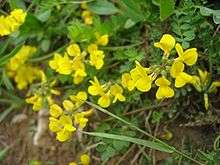Hippocrepis comosa
| Hippocrepis comosa | |
|---|---|
 | |
| Scientific classification | |
| Kingdom: | Plantae |
| (unranked): | Angiosperms |
| (unranked): | Eudicots |
| (unranked): | Rosids |
| Order: | Fabales |
| Family: | Fabaceae |
| Genus: | Hippocrepis |
| Species: | H. comosa |
| Binomial name | |
| Hippocrepis comosa L. | |
Hippocrepis comosa (horseshoe vetch[1]) is a flowering plant. Its overall appearance depends on its habitat. Sometimes it forms upright clumps of flowers and at other times sending prostrate leafy runners over areas of the downs and sometimes distributing itself as single flowers. Its common name comes from its horseshoe-like shaped pods although these flowers are considerably smaller than a horseshoe and typically flowers for a period of two weeks during the month of May. It has small yellow and sometimes orange/red flowers. The flowers often begin as orange/red and then become more yellow as they mature. It has a variable, relatively low, sometimes negligible seed production, but seedlings are still the main method of extending its range. It has a low germination rate in the wild, although this can be improved in nurseries. In England and Southern UK, Horseshoe Vetch is a calciole (found only on chalk and limestone). It is a hardy plant that survives long periods of cold winters and dry summers years after year. The habitable downland of Hippocrepis comosa is not harmed by sheep grazing and is resistant to moderate trampling, but does not thrive after heavy ploughing or disturbance of the ground. In areas grazed by cattle it disappears, sometimes after several years depending on grazing intensity. It is the exclusive food plant of the Chalkhill Blue and Adonis Blue Butterfly caterpillars. Populations of Horseshoe Vetch that support Chalkhill Blue Butterflies occur on long standing ungrazed meadows, quarries, edges of paths and wasteland. Only Horseshoe Vetch in southern England and the midlands on chalk, supports the Chalkhill Blue Butterfly and its larvae (The Gower in south Wales and Yorkshire Horseshoe Vetch do not support the Chalkhill Blues because of adverse climatic conditions). Horseshoe Vetch is difficult to sow directly into the ground and grow from seed and re-establishment of a colony is best attempted by planting individual plants. Even this however offers no guarantee of success (within a period as long as 20 years) and even less likelihood that the new plants will be used by significant populations of Chalkhill Blue Butterflies within another 50 years. From this long standing and well established relationship with the Chalkhill Blue butterfly it can be clearly seen how native species of insects depend on specific types of plant life for survival. [2] Hippocrepis comosa the sole food of the Chalkhill Blue butterfly larva, Polyommatus coridon.[3]
References
- ↑ "BSBI List 2007". Botanical Society of Britain and Ireland. Archived from the original (xls) on 2015-02-25. Retrieved 2014-10-17.
- ↑ Hippocrepis comosa
- ↑ Elizabeth Kolbert. Field Notes from a Catastrophe
| Wikimedia Commons has media related to Hippocrepis comosa. |
